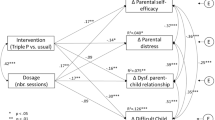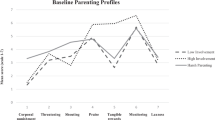Abstract
The study developed a multidimensional measure to assess participant responsiveness to a preventive intervention and applied this measure to study how participant baseline characteristics predict responsiveness and how responsiveness predicts program outcomes. The study was conducted with caregivers who participated in the parenting-focused component of the Family Bereavement Program (FBP), a prevention program for families that have experienced parental death. The sample consisted of 89 caregivers assigned to the intervention condition in the efficacy trial of the FBP. Positive parenting, caregiver depression, and child externalizing problems at baseline were found to predict caregivers' use of program skills outside the group, and more child internalizing problems predicted more positive perceptions of the group environment. Higher levels of skill use during the program predicted increased positive parenting at the 11-month follow-up, whereas positive perceptions of the group environment predicted decreased caregiver depressive symptoms at follow-up. Caregiver skill use mediated the relation between baseline positive parenting and improvements in positive parenting at 11-month follow-up, and skill use and perceived group environment mediated changes in caregiver depression from baseline to 11-month follow-up.


Similar content being viewed by others
Notes
Prior analyses using the data found that families with missing data did not differ from those with complete data on demographic variables (Kwok et al. 2005).
Loadings for the three-factor EFA indicated that home practice completion loaded on its own factor. The other variables related to the use of program skills (home practice efficacy, fidelity, frequency of skill use, and perceived skill helpfulness) loaded on a second factor, whereas variables associated with liking of the program and its environment (attendance, program satisfaction, and group environment subscales) loaded on a third factor.
References
Achenbach, T. M. (1994). Child behavior checklist and related instruments. In M. E. Maruish (Ed.), The use of psychological testing for treatment planning and outcome assessment (pp. 517–549). Hillsdale: Lawrence Erlbaum.
Administration, S. S. (2000). Intermediate assumptions of the 2000 trustees report. Washington: Office of the Chief Actuary of the Social Security Administration.
August, G. J., Egan, E. A., Realmuto, G. M., & Hektner, J. M. (2003). Parceling component effects of a multifaceted prevention program for disruptive elementary school children. Journal of Abnormal Child Psychology, 31, 515–527.
Ayers, T. S., Sandler, I. N., Twohey, J. L., & Haine, R. (1998, August). Three views of emotional expression in parentally bereaved children, Stress and coping in children and adolescents. Poster presented at the 106th Annual Convention of the APA, San Francisco.
Baydar, N., Reid, M. J., & Webster-Stratton, C. (2003). The role of mental health factors and program engagement in the effectiveness of a preventive parenting program for head start mothers. Child Development, 74, 1433–1453.
Beck, A. T., & Steer, R. A. (1984). Internal consistencies of the original and revised Beck Depression Inventory. Journal of Clinical Psychology, 40, 1365–1367.
Berkel, C., Mauricio, A., Schoenfelder, E., & Sandler, I. N. (2011). Putting the pieces together: An integrated model of implementation. Prevention Science, 12, 23–33.
Blake, S. M., Simkin, L., Ledsky, R., Perkins, C., & Calabrese, J. M. (2001). Effects of a parent–child communications intervention on young adolescents' risk for early onset of sexual intercourse. Family Planning Perspectives, 33, 52–61.
Brody, G. H., Murry, V. M., Chen, Y.-F., Kogan, S. M., & Brown, A. C. (2006). Effects of family risk factors on dosage and efficacy of a family-centered preventive intervention for rural African Americans. Prevention Science, 7, 281–291.
Burlingame, G. M., Fuhriman, A., & Johnson, J. E. (2001). Cohesion in group psychotherapy. Psychotherapy: Theory, Research, Practice, Training, 38, 373–379.
Carlson, M., & Gabriel, R. (2001). Patient satisfaction, use of services, and one-year outcomes in publicly funded substance abuse treatment. Psychiatric Services, 52, 1230–1236.
Dane, A., & Schneider, B. (1998). Program integrity in primary and early secondary prevention: Are implementation effects out of control? Clinical Psychology Review, 18, 23–45.
Dillman-Carpentier, F., Mauricio, A. M., Gonzales, N. A., Millsap, R. E., Meza, C. M., Dumka, L. E., Germán, M., & Genalo, M. T. (2007). Engaging Mexican origin families in a school-based preventive intervention. Journal of Primary Prevention, 28, 521–546.
Durlak, J., & DuPre, E. (2008). Implementation matters: A review of research on the influence of implementation on program outcomes and the factors affecting implementation. American Journal of Community Psychology, 41, 327–350.
Faschingbauer, T. R. (1981). Texas revised inventory of grief manual. Houston: Honeycomb.
Forgatch, M. S., Patterson, G. R., & DeGarmo, D. S. (2005). Evaluating fidelity: Predictive validity for a measure of competent adherence to the Oregon model of parent management training. Behavior Therapy, 36, 3–13.
Garland, A. F., Aarons, G. A., Saltzman, M. D., & Kruse, M. I. (2000). Correlates of adolescents' satisfaction with mental health services. Mental Health Services Research, 2, 127–139.
Garvey, C., Julion, W., Fogg, L., Kratovil, A., & Gross, D. (2006). Measuring participation in a prevention trial with parents of young children. Research in Nursing Health, 29, 212–222.
Gross, D., Garvey, C., Julion, W., Fogg, L., Tucker, S., & Mokros, H. (2009). Efficacy of the Chicago parent program with low-income African American and Latino parents of young children. Prevention Science, 10, 54–65.
Hazzard, A., Christensen, A., & Margolin, G. (1983). Children's perception of parental behaviors. Journal of Abnormal Clinical Psychology, 11, 49–60.
Holcomb, W. R., Parker, J. C., Leong, G. B., Thiele, J., & Higdon, J. (1998). Customer satisfaction and self-reported treatment outcomes among psychiatric inpatients. Psychiatric Services, 49, 929–934.
Jensen, E., Janes, S., Boyce, W. T., & Hartnett, S. A. (1983). The family routines inventory: Development and validation. Social Science Medicine, 17, 201–211.
Jones, S., & Twohey, J. L. (1998, August). Parents' expression of emotions questionnaire: Psychometric properties. Paper presented at the 106th Annual Convention of the American Psychological Association, San Francisco.
Kwok, O., Haine, R. A., Sandler, I. N., Ayers, T. S., Wolchik, S. A., & Tein, J. (2005). Positive parenting as a mediator of the relations between parental psychological distress and mental health problems of parentally bereaved children. Journal of Clinical Child and Adolescent Psychology, 34, 260–271.
Lambert, W., Salzer, M. S., & Bickman, L. (1998). Clinical outcome, consumer satisfaction, and ad hoc ratings of improvement in children's mental health. Journal of Consulting and Clinical Psychology, 66, 270–279.
Lutzke, J. R., Ayers, T. S., Sandler, I. N., & Barr, A. (1997). Risks and interventions for the parentally bereaved child. In S. A. Wolchik & I. N. Sandler (Eds.), Handbook of children's coping: Linking theory and intervention (pp. 215–243). New York: Plenum.
MacKinnon, D. P. (2008). Introduction to statistical mediation analysis. New York: Lawrence Erlbaum.
MacKinnon, D. P., & Dwyer, J. H. (1993). Estimating mediated effects in prevention studies. Evaluation Review, 17, 144–158.
McLellan, A. T., & Hunkeler, E. (1998). Patient satisfaction and outcomes in alcohol and drug abuse treatment. Psychiatric Services. Special Issue: Women and Chronic Mental Illness, 49, 573–575.
Melhem, N., Moritz, G., Walker, M., Shear, M., & Brent, D. (2007). The phenomenology and correlates of complicated grief in children and adolescents. Journal of the American Academy of Child and Adolescent Psychiatry, 46, 493–499.
Moos, R. (1994). Group environment scale manual: Development, applications, research (3rd ed.). Palo Alto: Consulting Psychologists Press.
Muthén, L., & Muthén, M. (2008). Mplus user's guide. Los Angeles: Muthén & Muthén.
Oregon Social Learning Center. (1991). LIFT parent interview. Unpublished Manual.
Orrell-Valente, J. K., Pinderhughes, E. E., Valente, E., & Laird, R. D. (1999). If it's offered, will they come? Influences on parents′ participation in a community-based conduct problems prevention program. American Journal of Community Psychology, 27, 753–783.
Pekarik, G., & Wolff, C. (1996). Relationship of satisfaction to symptom change, adjustment, and clinical significance. Professional Psychology: Research and Practice, 27, 202–208.
Prinz, R. J., Foster, S. L., Kent, R. N., & O'Leary, K. D. (1979). Multivariate assessment of conflict in distressed and nondistressed mother–adolescent dyads. Journal of Applied Behavior Analysis, 12, 691–700.
Sandler, I. N., & Guenther, R. (1985). Assessment of life stress events. In P. Karoly (Ed.), Measurement strategies in health psychology. New York: Wiley.
Sandler, I. N., Ayers, T. S., Wolchik, S. A., Tein, J., Kwok, O., Haine, R. A., et al. (2003). The family bereavement program: Efficacy evaluation of a theory-based prevention program for parentally bereaved children and adolescents. Journal of Consulting and Clinical Psychology, 71, 587–600.
Schaefer, E. S. (1965). Children's reports of parental behavior: An inventory. Child Development, 36, 413–424.
Sobel, J. (1982). Asymptotic confidence intervals for indirect effects in structural equation models. In S. Leinhardt (Ed.), Sociological methodology 1982 (pp. 290–312). San Francisco: Jossey Bass.
Spoth, R., & Redmond, C. (1995). Parent motivation to enroll in parenting programs: A model of family context and health belief predictors. Journal of Family Psychology, 9, 294–310.
Spoth, R., & Redmond, C. (2000). Research on family engagement in preventive interventions: Toward improved use of scientific findings in primary prevention practice. Journal of Primary Prevention, 21, 267–284.
Tein, J., Sandler, I. N., Ayers, T. S., & Wolchik, S. A. (2006). Mediation of the effects of the family bereavement program on mental health problems of bereaved children and adolescents. Prevention Science, 7, 179–195.
Wolchik, S. A., West, S. G., Sandler, I. N., Tein, J., Coatsworth, D., & Lengua, L. (2000). An experimental evaluation of theory-based mother and mother-child programs for children of divorce. Journal of Consulting & Clinical Psychology, 68, 843–856.
Worden, J. W., & Silverman, P. R. (1996). Parental death and the adjustment of school-age children. Omega: Journal of Death and Dying, 33, 91–102.
Acknowledgments
The writing of this paper was funded in part by the National Institute of Health grant R01MH049155-06, gratefully acknowledged.
Author information
Authors and Affiliations
Corresponding author
Electronic supplementary material
Below is the link to the electronic supplementary material.
ESM 1
(DOCX 26 kb)
Rights and permissions
About this article
Cite this article
Schoenfelder, E.N., Sandler, I.N., Millsap, R.E. et al. Caregiver Responsiveness to the Family Bereavement Program: What Predicts Responsiveness? What Does Responsiveness Predict?. Prev Sci 14, 545–556 (2013). https://doi.org/10.1007/s11121-012-0337-7
Published:
Issue Date:
DOI: https://doi.org/10.1007/s11121-012-0337-7




